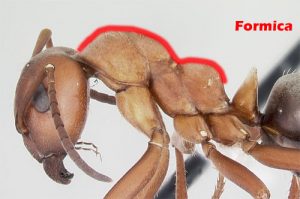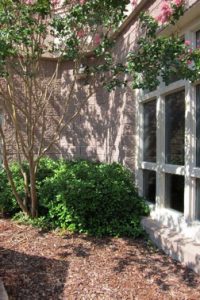Formica ants, often referred to as field ants, are among the United States’ largest and most common ants. Distributed throughout NC, three species make the most common list: Formica pallidefulva and Formica incerta, both rust to red in color, and Formica subsericea, black in color with stripes of sparse golden hairs across their abdomens. Field ants have polymorphic (multiple-sized) workers ranging in size from ⅛ – ⅜ inches.
Field ants are commonly mistaken for carpenter (Camponotus) ants. Both are common, medium to large in size, with one node in between the thorax and abdomen. However, the two are quite easy to distinguish with a little practice.
If you look at a carpenter worker ant in side profile, you will notice that its thorax is evenly rounded and forms a single curve (see photo on left below). If you look at a field ant in side profile, you’ll notice that is thorax is not evenly rounded, but that it is broken into two distinct curves (see photo on right below).

An evenly rounded thorax indicates Camponotus. (Image by Antweb.org)

A thorax with two distinct curves indicates Formica. (Image by Antweb.org)
Field ants do not have a stinger, but instead they possess a circlet of hairs around an opening at the tip of their abdomen where formic acid is expelled as a defense mechanism. They may pinch skin with their mouthparts, and then squirt formic acid into the wound, which may feel like being stung.
They are found around structures, but do not often invade homes. They often nest in soil, but nests also may be found under lawn and wood debris such as stacks of firewood, bricks, stepping stones, potted plants, and other protected places. They may also be found nesting in foundation voids.
If control is necessary, try following workers back to their nest site. Once the nest is located, a mound drench with an appropriately labeled insecticide is an option. Or granular bait can be applied around the mound.
If ants are entering structures, a thorough perimeter treatment up and along the foundation wall an appropriate insecticide may be necessary. Treat around doorways and windows, and underneath siding.

Vegetation touching structures should be trimmed back (Image by Patty Alder, NCSU)
In addition, make sure all potential entry points are sealed, especially where electrical and utility lines enter buildings. Any vegetation in contact with the foundation should be trimmed back, if possible (see image at right). Reduce or eliminate sources of moisture around the structure, and store firewood, piles of lumber, and other such items away from the foundation

